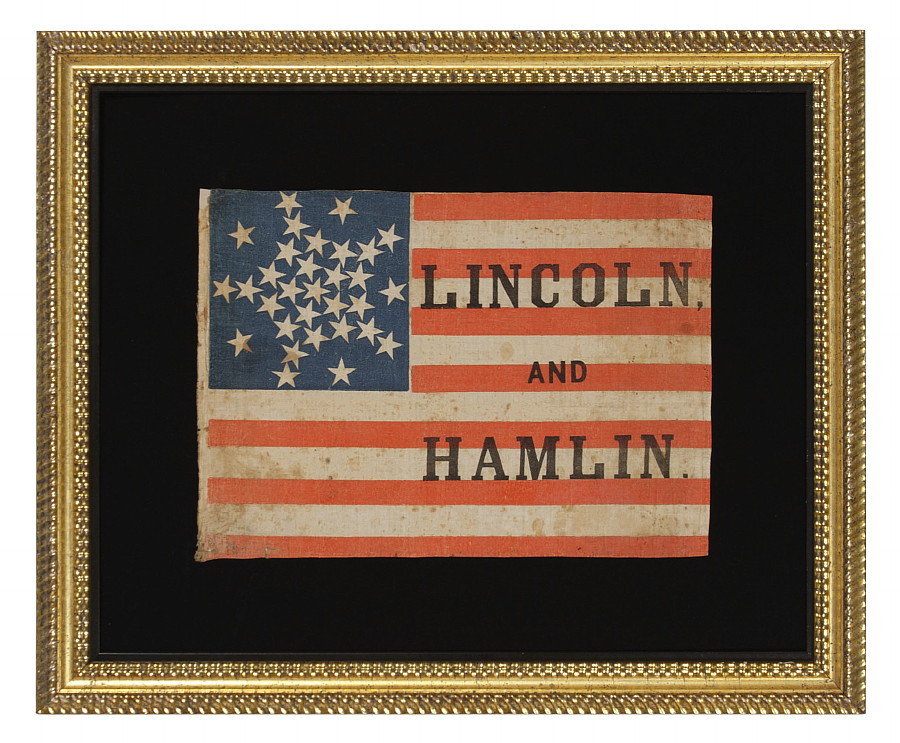
| |
31 STARS IN AN INTERESTING VARIATION OF THE "GREAT STAR" CONFIGURATION, MADE FOR THE 1860 CAMPAIGN OF ABRAHAM LINCOLN & HANNIBAL HAMLIN |
|
| Available: |
Sold |
| Frame Size (H x L): |
20.5" x 25" |
| Flag Size (H x L): |
11" x 15.5" |
|
| Description....: |
|
31 STARS IN AN INTERESTING VARIATION OF THE "GREAT STAR" CONFIGURATION, MADE FOR THE 1860 CAMPAIGN OF ABRAHAM LINCOLN & HANNIBAL HAMLIN:
31 star American parade flag, printed on glazed cotton, made for the 1860 campaign of Abraham Lincoln & Hannibal Hamlin. Among printed parade flags, those made for the political campaign of President Lincoln are collectively the most desired, and this is an especially fine example due to its whimsical star design, attractive text and bold colors. The stars of the flag are arranged in a whimsical variation of what is known as the "Great Star" or "Great Luminary" pattern, in which the smaller stars form a single, large star. Great star configurations take many forms. In this particular design, note that a pentagon of five stars surrounds a single, center star. Around this is another would-be pentagon, but two stars protrude in a linear fashion from each corner to create a somewhat fat, large star with extended, pointy arms and concave, semi-circular valleys. This interesting interpretation also bears a star between each arm, just beyond their outermost point of intersection. This forms a circle within the outermost ten stars and for this reason it can be more accurately termed a "Great-Star-In-A-Wreath".
On this particular flag, the words Lincoln & Hamlin are overprinted in black across the field of stripes. This means that the advertising was added to the flag after the red and blue were printed. This was the standard practice, though some advertising flags have verbiage (as well as symbols and portraits) that are printed simultaneously with the blue used in the canton. While this exact form of Lincoln & Hamlin campaign flag remains undocumented, a smaller example with the same star pattern pictured in "Threads of History: Americana Recorded on Cloth, 1775 to the Present", by Herbert Ridgeway Collins (1979, Smithsonian Press) as item 294 on page 157. This is the best text on American political textiles. Collins formerly served as Curator of Political History at the Smithsonian Institution. The flag pictured is less desirable due to its smaller scale. Generally speaking, the larger a campaign parade flag is, the more rare it is and the more desirable.
It is interesting to note that Lincoln was hardly the favorite at the beginning of the campaign, winning the Republican nomination from the 3rd ticket. He then defeated John Bell (Constitution Party), John Breckinridge (Southern Democrat), and Stephen Douglas (Northern Democrat), to become the Republican party's first president. Lincoln was elected with a mere thirty-nine percent of the vote and carried no state south of the Mason-Dixon line.
31 star flags are extremely scarce. The 31st state, California, entered the Union on September 9th, 1850, immediately following the Gold Rush. The 31 star flag was official from 1851-1858, but this flag was obviously in use after that time. This means one of two things. Either the flag was printed in the 1850-1858 period, then overprinted in 1860. Or an older print block was used to create a flag of a specific size or star design, per the customer's wishes, in 1860. This is by no means unusual across known political campaign flags. In fact, other Lincoln-Hamlin flags exist that share this star count.
Flags made prior to the Civil War are rare, comprising less than one percent of 19th century flags that survive in the 21st century. This is partly because our flag wasn't used in the same purposes in early America. Private individuals did not generally display the flag. Use of the Stars & Stripes for functions of general patriotism rose swiftly following the 1861 attack on Fort Sumter that spurred the Civil War (1861-65). This was the beginning of widespread civilian use, which grew substantially throughout the remainder of the 19th century.
Mounting: The gilded American frame has a rippled profile and dates to the period between 1830 and 1860. To this a ca 1860-70 ebonized liner was added. The flag has been hand-stitched to 100% cotton twill, black in color. The black cotton was washed to remove excess dye. An acid-free agent was added to the wash to further set the dye and the fabric was heat-treated for the same purpose. Spacers keep the textile away from the glazing, which is U.V. protective glass.
Condition: There is very minor to moderate foxing and staining throughout, accompanied by a small area of loss in the top, fly-end corner and two very minor tears in the last stripe, near the bottom, fly-end corner. Many of my clients prefer early flags to show their age and history of use. Further, the flag is exceptionally bold and its rarity well-warrants any condition issues. |
|
|
|
| Collector Level: |
Flags for the truest Patriots. My best offerings |
|
| Flag Type: |
Parade flag |
|
| Star Count: |
31 |
|
| Earliest Date of Origin: |
1860 |
|
| Latest Date of Origin: |
1860 |
|
| State/Affiliation: |
California |
|
| War Association: |
1777-1860 Pre-Civil War |
|
| Price: |
SOLD |
|
| |
Views: 3171 |
|
|
|

